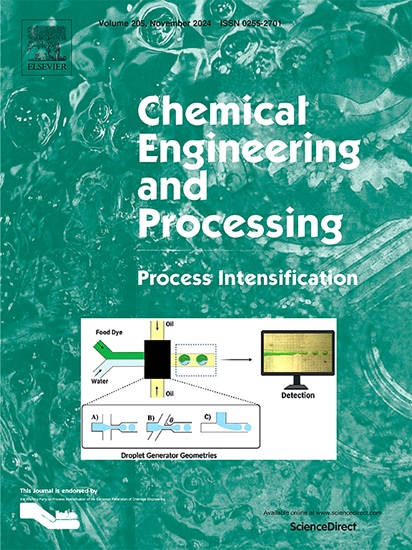反应含率对工艺配置选择的影响:乙酰丙酸乙酯生产工艺是否可能有一个整洁的反应精馏塔?
IF 3.9
3区 工程技术
Q3 ENERGY & FUELS
Chemical Engineering and Processing - Process Intensification
Pub Date : 2025-06-10
DOI:10.1016/j.cep.2025.110400
引用次数: 0
摘要
生物柴油除了有许多优点外,也有一些缺点,需要使用燃料添加剂。因此,乙酰丙酸乙酯具有较好的冷流动性能和较高的含氧量,成为替代燃料添加剂之一。在关于乙酰丙酸乙酯生产工艺的文献中,过量的反应物被用来克服转化限制。这导致多柱工艺配置,其中除了反应塔外,还使用额外的蒸馏塔来分离多余的反应物。在这项研究中,提出了一个具有成本效益的工艺配置的概念设计,包括一个单一的反应精馏塔。这个想法是基于在反应托盘上使用合理较高的液含率,以获得显着更高的转化率,并消除乙醇的过量使用。结果,乙酰丙酸乙酯的期望纯度是通过一个整洁的反应精馏塔实现的,与文献中过量的乙醇配置相比,它减少了年总成本34%。此外,针对该工艺配置设计了控制结构,并评估了其对进料流量和组成干扰的鲁棒性。动态仿真结果表明,该反应精馏塔的基位调节控制效果良好。本文章由计算机程序翻译,如有差异,请以英文原文为准。

Impact of reactive holdup on process configuration selection: Is a neat reactive distillation column possible for ethyl levulinate production process?
Besides several advantages, biodiesel has some shortcomings which need the utilization of fuel additives. At this point, ethyl levulinate comes forward as one of the alternative fuel additives with its better cold flow properties and high oxygen content. In the literature on ethyl levulinate production processes, excess of a reactant is used to overcome conversion limitations. This results in multi-column process configurations where additional distillation columns besides a reactive column are used to separate excess reactant. In this study, the conceptual design of a cost-effective process configuration including a single reactive distillation column is proposed. This idea is based on the use of a reasonably higher liquid holdup on reactive trays to get significantly higher conversion and eliminate the excess usage of ethanol. As the result, the desired purity of ethyl levulinate is achieved by a neat reactive distillation column which reduces the total annual cost by 34 % compared to the excess ethanol configuration in the literature. In addition, a control structure is designed for this process configuration, and its robustness is evaluated against disturbances in feed flowrate and composition. Dynamic simulation results show satisfactory base-level regulatory control for this neat reactive distillation column.
求助全文
通过发布文献求助,成功后即可免费获取论文全文。
去求助
来源期刊
CiteScore
7.80
自引率
9.30%
发文量
408
审稿时长
49 days
期刊介绍:
Chemical Engineering and Processing: Process Intensification is intended for practicing researchers in industry and academia, working in the field of Process Engineering and related to the subject of Process Intensification.Articles published in the Journal demonstrate how novel discoveries, developments and theories in the field of Process Engineering and in particular Process Intensification may be used for analysis and design of innovative equipment and processing methods with substantially improved sustainability, efficiency and environmental performance.

 求助内容:
求助内容: 应助结果提醒方式:
应助结果提醒方式:


